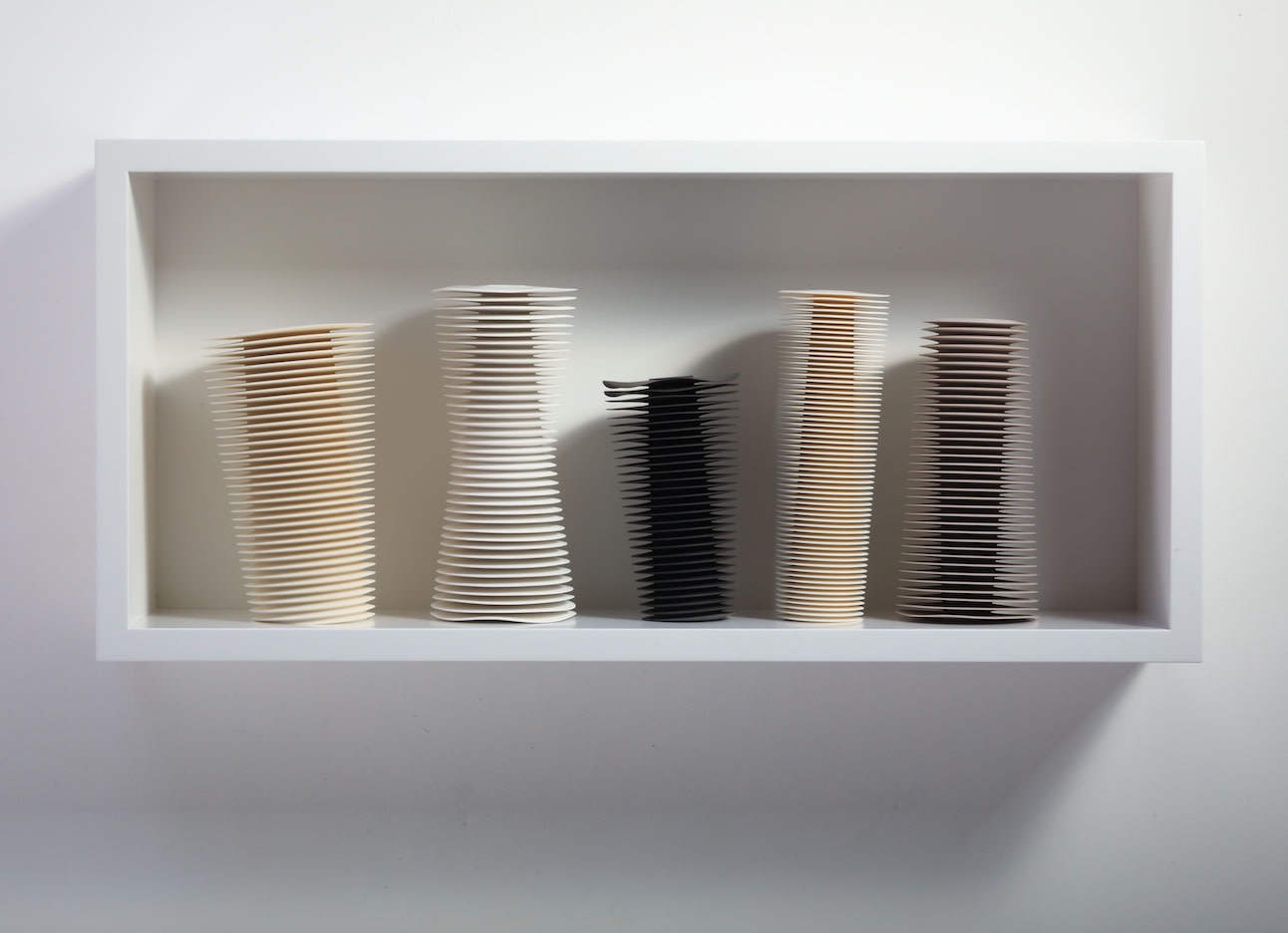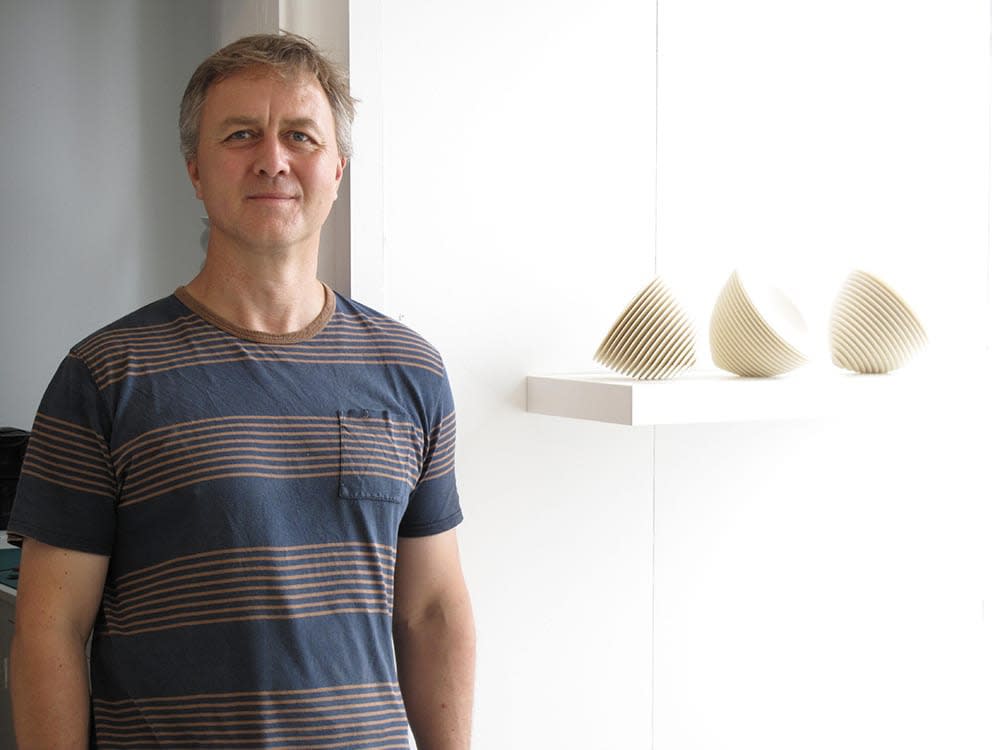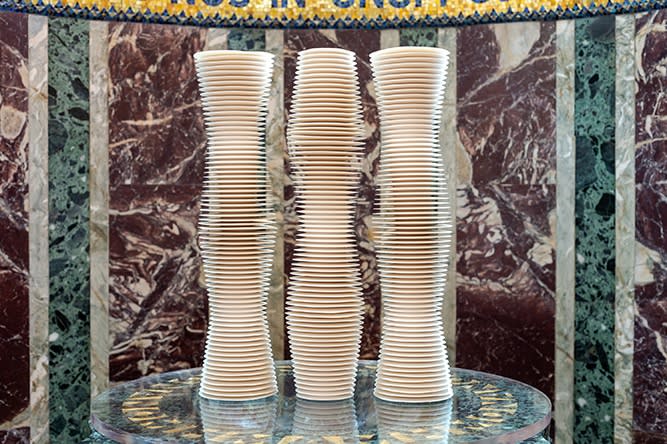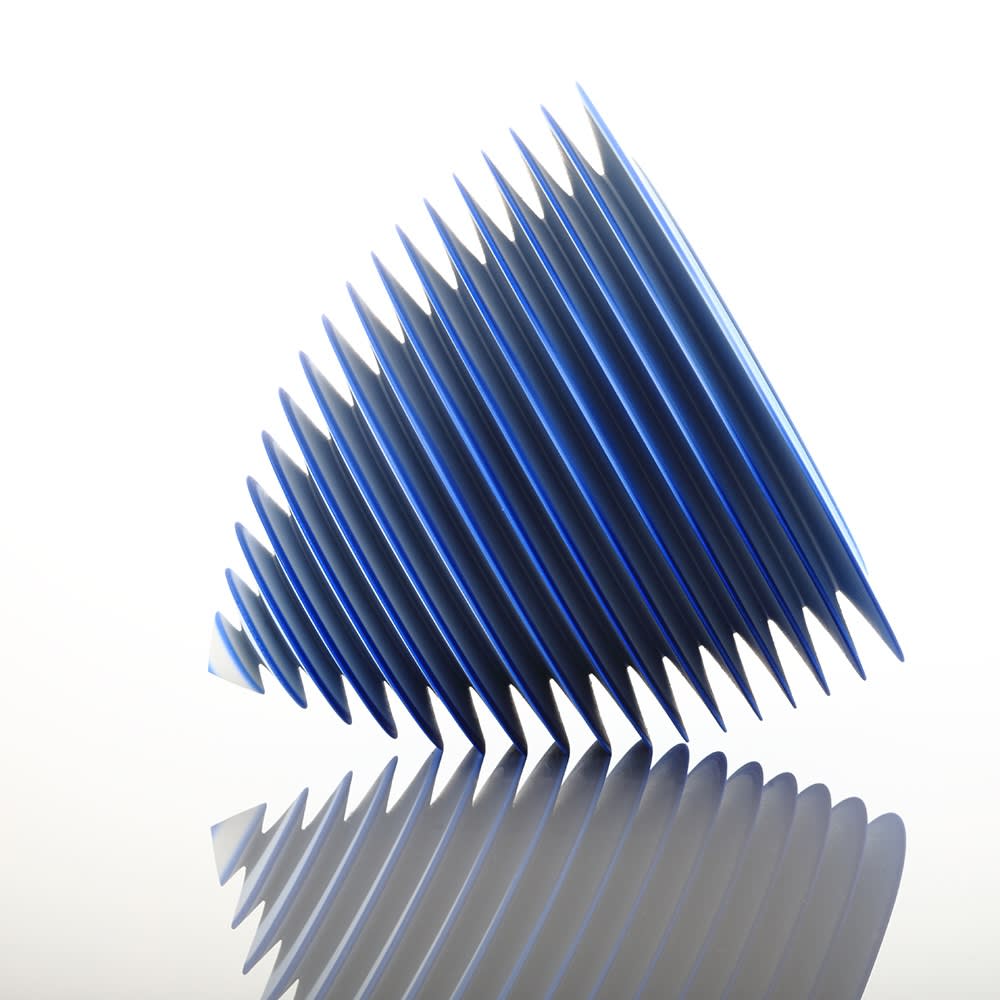-
We first met Nicholas Lees in Venice at Homo Faber in 2018. Nicholas’ work had been selected for the Best of Europe exhibition at Homo Faber alongside work by a few other Cavaliero Finn’s artists, Frances Priest, Ashraf Hanna and Matthew Chambers. Shortly after this meeting, we paid a visit to Nicholas’ studio in Hampshire and our belief that his work would sit well within the Cavaliero Finn portfolio was confirmed. We were completely smitten.

Littoral 3 – Five Piece Framed Installation, H 40 x W 85 x D 20cm. Parian, grey Parian, bone china, black porcelain, painted fibreboard, 2020
Nicholas is currently still able to work from his studio during the lockdown as it is a short walk across a field from his family home. We touched base with him this week and chatted to him about his work.

Nicholas Lees in his studio in Hampshire
CF: How did you become an artist Nicholas?
NL: I first became interested in ceramics in 6th form. After having initially studied History and English Literature, I went to Bristol Polytechnic to study Ceramics. Since then I have had spells of different forms of practice interspersed with bouts of education and I have also done a lot of teaching. Having begun as a potter I would now describe myself as an artist or a sculptor. However, the relationship to a material discipline is very important to me. I use my depth of knowledge of the medium and think through making.
CF: Your work explores the effects of light on our perception of the natural world. Can you tell us a bit more about this and how this is achieved in your work?
NL: My work originated from an interest in the ephemerality and uncertainty of perception. I’ve thought long and hard about what made me interested in this in the first place and I think that these ideas have been heavily informed by visits to the Scottish Coastline which I have done every year throughout my life. Visiting the same place, year after year, has brought about the realisation that the constant shift of tide, weather and light mean the experience of perception is forever transient. My work originated in looking at the effects of light and shade and trying to manifest these in ceramic. I have now come to think of light and space as equivalent material elements in my making to porcelain. I have always been interested in boundaries in the landscape and interfaces between different forms and states and have come to think about these more and more. Examples are the cutting lines in hedges, trees growing around hard forms and the intertidal zone at the coast. The work is about perception over time – looking and looking again reveals the ephemerality of perception. The use of fins on hard-edged forms means that as light conditions change and viewpoint alters, the boundary between presence and absence of the object shifts.
Triptych (19.35), H62 x W45 x D15 cms, porcelain Parian, 2019
CF: Walk us through making one of your sculptures, what materials and techniques do you use?
NL: I primarily use Parian – a porcelaneous clay body first developed in the 19th century to imitate creamy white Greek marble. I use it as I don’t glaze my pieces and it has a nice vitrified surface finish. I do occasionally colour the Parian through blending and also use bone china for its intense whiteness, as well as a black porcelain. The pieces originate on the wheel, where they are made as deliberately thick-walled vessels with tapering width to the walls. This can feel a bit contrary, as learning to throw properly involves the aspiration to thinness and evenness! I dry the pieces slowly, continually wrapping and unwrapping them over a period of weeks, in order to achieve an even dryish leather-hard state which must be consistent through the thickness of the clay. When ready, a piece is mounted on the lathe by being jammed onto a specially turned plaster chuck. Sometimes the pieces undergo a horizontal boring process before they are turned to give extra grip or to add a different artistic note. The turning involves some measuring but is largely done by eye using specially made tools – it can take up to 6 hours for an individual piece. The pieces are then fired once. After firing I use diamond abrasive to grind angles and bases on to the pieces. Some pieces are assembled from multiple parts ground to fit precisely and glued together.The painstaking process of using the lathe machine after the initial vessel is created on the wheel by Nicholas
CF: How did you arrive at your technique of switching from wheel to lathe?
NL: This work originated from my study for an MPhil by a project at the RCA. I was interested in examples of transitions between 2 and 3 dimensions, and this led me to consider shadows and silhouettes. I was interested in capturing some of the ephemeral qualities of the blurred edge of a shadow. I was doing a lot of tests around the idea of making an object which had an uncertain boundary and appeared to be half present. Thinking about the need to remove some of the clay I experimented with turning. I always loved this stage of the process when I used to make more functional thrown work – I particularly like clay in its leather hard stage. I realised and was interested in, the reference to the making of ceramic electrical insulators, as well as to the history of throwing and lathe turning as used by Wedgwood since the 18th century.
One of three Blue Floating Bowls purchased for The Fitzwilliam Museum on behalf of Sir Nicholas and Judith Goodison (SOLD)
CF: At Cavaliero Finn’s recent show Alter, three of your Blue Floating Bowls were bought by the Fitzwilliam Museum in Cambridge for its permanent collection. What made you introduce colour into your work?
NL: The introduction of colour was inspired by my works on paper with ink, actually. I started experimenting with soluble metal salts in colouring ceramic, which is an unusual technique, to try and mimic the way that ink soaks into the paper. I found that if I worked with a solution of Cobalt Sulphate applied to the interior of the biscuit fired sculpture and then saturated it with water, as the sculpture dried the colour moved through the sculpture and concentrated onto the edges of the ‘fins’. The Cobalt moved to edges of the sculpture because there was a suction caused by faster evaporation from those edges. It was really quite beautiful and everything I was trying to achieve.
Blue Floating Bowl 19.43 , H13 x Ø12.5 , Parian and soluble cobalt, 2019
CF: You mention your works on paper, why do you work in both 2d and 3D is the 2d work a precursor to the 3d or does it exist independently of your sculptures?
NL: The work on paper is a parallel activity – another way of thinking about some of the same ideas, through a different medium. It has the advantage of immediacy and so is a good occasional antidote to the slow iteration of ideas in ceramics. Sometimes the drawing helps push the sculpture forwards and sometimes it’s the other way around.
Nicholas Lees Leaning Vessels alongside one of his ink drawings.
CF: Your work is extremely precise, how do you deal with making mistakes in your work?
NL: Occasionally I swear very loudly! However working in ceramics for a long time helps to make one somewhat philosophical about the many things that can go wrong at the various stages of the process.

Nicholas Lees Floating Bowl, Porcelain
CF: Which artists particularly inspire you and why?
NL: Amongst many others; Hans Coper – looking at his work first got me hooked on ceramics. Elizabeth Fritsch – gorgeous objects and I love the play of dimensions and realities. Rachel Whiteread – for her investigations into presence and absence. David Nash – materiality and time. Anthony McCall – light as material, ephemerality and substance.
Ceramics by Hans Coper (1920 – 1981), arguably one of Britain’s most important post-war ceramic artists – image courtesy of Auction Publicity
CF: You are a lecturer at the RCA, UCA Farnham and Bath Spa University, in fact, you taught Matthew Chambers didn’t you? Do you feel this enriches your work and if so in what way? Can you give an example?
NL: I did have the pleasure to teach Matt at Bath Spa University and although I didn’t teach Mimi Joung, she did come and do a placement with us from the RCA so I’ve worked with her too. I really enjoy teaching. It means I am engaged with a great range of people, ideas and points of view. Also you have to constantly challenge your own preconceptions in helping students to find new ways of thinking and working. There is a process of continually trying to see and to open up potentials without being proscriptive, and I am sure that this helps my thinking about my own work. In talking to students in tutorials, I can find myself saying things I need to hear as much as they do.“I have now come to think of light and space as equivalent material elements in my making to porcelain” Nicholas Lees in conversation with Cavaliero Finn CF: Tell us one piece of advice you give aspiring ceramicists?
NL: Develop skills. The ‘how’ of making work is central to the ‘what’ and the ‘why’.
Set of three Leaning Vessels by Nicholas Lees
To see more of Nicholas’ available work click here.